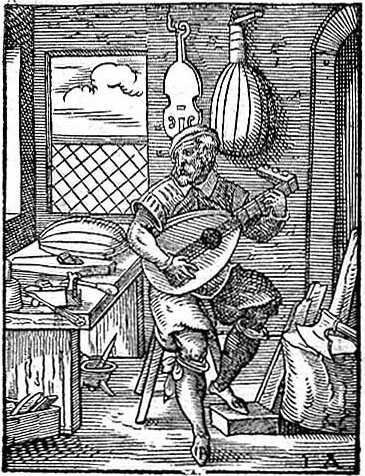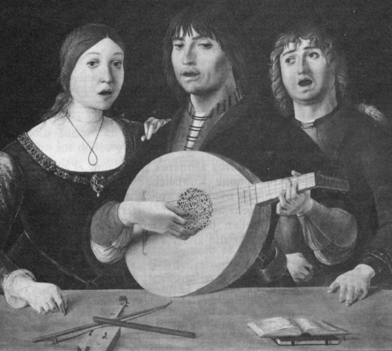The Medieval Lute
1400's

Medieval lutes were 4- or 5-course instuments, plucked using a quill for a plectrum. There were several sizes, and by the end of the Renaissance, seven different sizes (up to the great octave bass) are documented. Song accompaniment was probably the lute's primary function in the Middle Ages, as it had been in Arab culture.
In the 1400's the lute experienced major changes in its construction and playing techniques.
a. The addition of frets, already in use by other small plucked instruments
b. The gradual shift from plectrum to finger technique
The lute players of the XVc.were artists who organized themselves into fraternities, and thus were able to establish themselves in the structure of society. They were educated, literate and their surviving manuscripts show that they knew the basic rules of polyphonic composition. Composers of vocal music, such as Baude Cordier, Jacob Senleches and Rodriguet de la guitarra, also worked as instrumentalists, and the famous organist Konrad Paumann, was well known for his lute playing. Recently discovered documents suggests a close connection between the organ and lute repertoire.
Private music making became more popular during the XV century, which ultimately led to the didactic prints by Virdung and Judenküning among others.
Lute Tablature
Instructions in Italy: A Survey of the Regole from 1507 to 1759
by Dinko Fabris
Cambridge Studies in Performance Practice
|
If you love the honourable
bliss of the Sun-like lute Once you stir its tender strings with a skilled
finger |
 |
Repertoire
Fifteen century lutenists, like their later counterparts, liked to use popular songs as models for their arrangements, called Intabulations; the writing down of the individual voices of a composition onto one musical staff. One way to realize a vocal piece was to take one voice, normally the tenor, against which one or two parts were composed. Very much like church music singing, super librium upon a cantus firmus or the extempore melodic playing of courtly danses such as the bassadanza. The musical forms where, Rondos, Virelai, Ballade, Chansons, played in settings like the Burgundian Court.
The lute of this time was almost exclusively used as a consort instrument, paired with cornets, sackbut, shaums, slide trumpet, harps, cittern, and percussion. This assumption is based on the fact that there are no manuscripts of notated solo music for the instrument before the end of the XV c. The lute was not considered a solo instrument until the time of Johannes Tinctoris Johannes Tinctoris (1435-1511) when the shift from monody to polyphony occured.
The
Role of the Guitar in the Rise of Monody: The
Earliest Manuscripts by
James Tyler.
The Journal of Seventeenth Century Music
 |
 |
|
Tuning The medieval lute shared the same tuning as the vihuela and modern day guitar |

The Facciata dei Torricini (the two-tower facade) of the Palazzo Ducale, Urbino, seat of Duke Federico di Montefeltro (1444-1482), whose famous profile portrait – painted by Piero della Francesca in 1466 – hangs in the Uffizi, Florence.
Composers
Ugolino d'Orvieto (ca. 1380-1457)
Josquin des Prez (?) (ca. 1480)
Loyset Compère (ca. 1445-1518)
Walter Frye (?) (ca. 1460)
Domenico da Piacenza (before 1455)
Antoine Brumel (ca. 1460-ca. 1515)
Alexander Agricola (ca. 11446-1506)
Discography
Intabulations: Lute Music 1440-1500 Crawford Young D-79276 Reute Germany
© 2006 Patricia A. Dixon